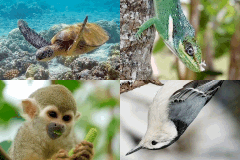AnAge entry for Meriones unguiculatus
Classification (HAGRID: 02686)
- Taxonomy
-
Kingdom: Animalia
Phylum: Chordata
Class: Mammalia (Taxon entry)
Order: Rodentia
Family: Muridae
Genus: Meriones
- Species
- Meriones unguiculatus
- Common name
- Mongolian jird
- Synonyms
- Gerbillus koslovi, Meriones kurauchii, Meriones kurauchii chihfengensis
Lifespan, ageing, and relevant traits
- Maximum longevity
- 6.3 years (captivity)
- Source
- ref. 671
- Sample size
- Medium
- Data quality
- Acceptable
- Observations
Females reproduce until they are 20 months old. Average lifespan in the wild is less than 6 months [0434]. One captive specimen lived 6.3 years [0671]. In contrast to rats, hearing loss did not appear to correlate with expression of GABA in Mongolian jirds [1191].
Life history traits (averages)
- No information is available on life history. Please contact us if you wish to suggest or contribute data.
Metabolism
- Typical body temperature
- 311ºK or 38.2ºC or 100.8ºF
- Basal metabolic rate
- 0.5460 W
- Body mass
- 64.8 g
- Metabolic rate per body mass
- 0.008426 W/g
References
- [1191] Gleich et al. (2014), Comparing the inferior colliculus of young and old gerbils (Meriones unguiculatus) with an emphasis on GABA (PubMed)
- [0949] Lee et al. (2011), Heat shock protein 90 and its cochaperone, p23, are markedly increased in the aged gerbil hippocampus (PubMed)
- [0775] Brummelte and Teuchert-Noodt (2007), Density of dopaminergic fibres in the prefrontal cortex of gerbils is sensitive to aging (PubMed)
- [0776] Seluanov et al. (2007), Telomerase activity coevolves with body mass not lifespan (PubMed)
- [0734] Scarano et al. (2006), Tissue evidence of the testosterone role on the abnormal growth and aging effects reversion in the gerbil (Meriones unguiculatus) prostate (PubMed)
- [0671] Richard Weigl (2005), Longevity of Mammals in Captivity; from the Living Collections of the World
- [0036] Savage et al. (2004), The predominance of quarter-power scaling in biology
- [0372] Arkin et al. (2003), Age-related changes on marking, marking-like behavior and the scent gland in adult Mongolian gerbils (Meriones unguiculatus) (PubMed)
- [0420] White and Seymour (2003), Mammalian basal metabolic rate is proportional to body mass2/3 (PubMed)
- [0610] Ernest (2003), Life history characteristics of placental non-volant mammals
- [0373] Dawirs et al. (2000), Granule cell proliferation and axon terminal degradation in the dentate gyrus of gerbils (Meriones unguiculatus) during maturation, adulthood and aging (PubMed)
- [0434] Ronald Nowak (1999), Walker's Mammals of the World
- [0374] Spangler et al. (1997), An assessment of behavioral aging in the Mongolian gerbil (PubMed)
- [0377] Bingel (1995), Pathologic findings in an aging Mongolian gerbil (Meriones unguiculatus) colony (PubMed)
- [0375] Sohal et al. (1995), Oxidative stress and aging in the Mongolian gerbil (Meriones unguiculatus) (PubMed)
- [0455] Virginia Hayssen et al. (1993), Asdell's Patterns of Mammalian Reproduction: A Compendium of Species-Specific Data
- [0542] Bernhard Grzimek (1990), Grzimek's Encyclopedia of Mammals
- [0376] Langley and Gray (1987), Age-related susceptibility of the gerbil, Meriones unguiculatus, to the bovine parasite, Babesia divergens (PubMed)
- [0680] Wootton (1987), The effects of body mass, phylogeny, habitat, and trophic level on mammalian age at first reproduction
- [0731] Zullinger et al. (1984), Fitting sigmoid equations to mammalian growth curves
- [0571] National Gerbil Society
External Resources
- Integrated Taxonomic Information System
- ITIS 632988
- Animal Diversity Web
- ADW account
- Encyclopaedia of Life
- Search EOL
- NCBI Taxonomy
- Taxonomy ID 10047
- Entrez
- Search all databases
- Ageing Literature
- Search Google Scholar or Search PubMed
- Images
- Google Image search
- Internet
- Search Google

